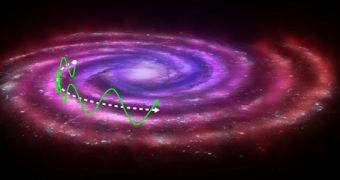A new scientific model developed by a duo of theoretical physicists suggests that dark matter may have been responsible for some of Earth's global extinction events. This happened due to a thin disk of dark matter that lies in the Sun's path as the star orbits the core of the Milky Way. Whenever our solar system passes through the disk, dark matter causes meteorites to bombard all planets, the work argues.
Several extinction events are thought to have been caused by meteorite impacts, scientists agree. The new model comes as an overarching concept that relates the mysterious form of matter known as dark matter to the chances large meteorites, comets, or asteroids have of impacting our planet.
Interestingly, the new study is based on a research the team and other associates conducted last year, when they proposed a hypothetical form of dark matter for explaining another cosmic mystery. However, if such a thin disk does exist, its effects on our solar system could trigger extinctions here on Earth, the group explains.
The work was conducted by experts Lisa Randall and Matthew Reece, who both hold appointments as theoretical physicists at the Harvard University in Cambridge, Massachusetts. They say that the Sun not only revolves around the galactic core, but also moves up and down as it does so, moving below and above the galactic plane multiple times during a single orbit.
What the team is suggesting is that the very middle of the galactic plane contains higher concentrations of dark matter, which exert a more massive gravitational pull on our solar system. While the Sun itself and adjacent planets are not that affected, this does trigger changes in the orbits of smaller bodies, including asteroids in the Inner Asteroids Belt and the Kuiper Belt, and comets in the Oort Cloud.
An encouraging aspect of the new research is that the thin dark matter disk may actually be detected over the next 5 years. If it exists, it is highly likely that the European Space Agency's (ESA) newly-launched Gaia mission will see it. Dark matter cannot be detected directly, but indirect observations are possible, Nature News reports.
Gaia will conduct a survey of more than 1 billion stars in our galaxy, mapping their positions, speeds, and headings over half a decade. The astrometry data will then be used to create a 3D map of the Milky Way. If the thin disk exists, then its gravitational influence on nearby stars will be observed.
Dark matter, which makes up an estimated 23 percent of the Universe's mass-energy budget, is believed to be made up of weakly-interacting massive particles (WIMP). As their names imply, these particles do not interact with regular, baryonic matter, except through gravity. Being larger and much heavier than baryons, WIMP attract the latter.
The Universe is believed to contain a massive network of dark matter filaments. Galaxies travel along these filaments and form clusters wherever two or more of these highways meet.

 14 DAY TRIAL //
14 DAY TRIAL //